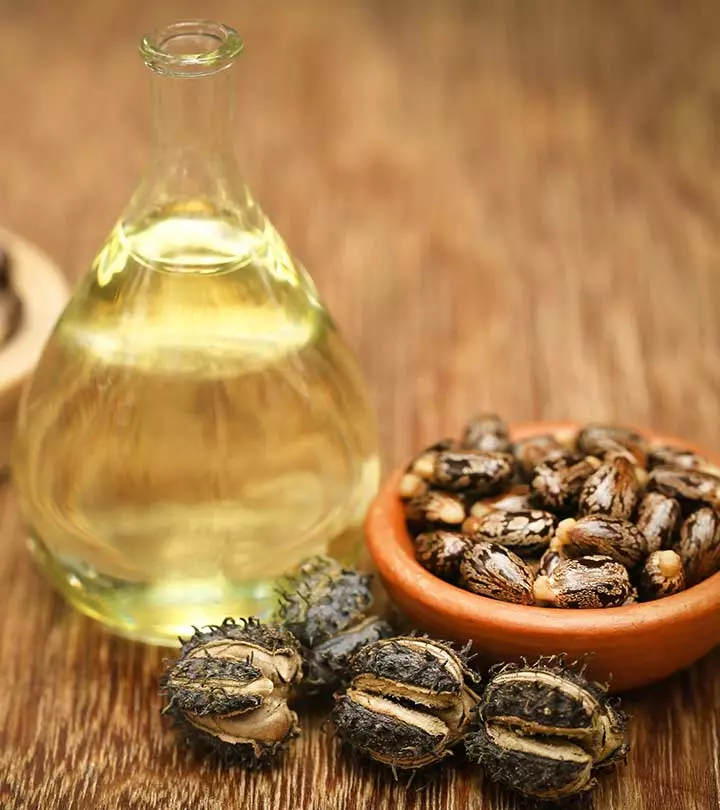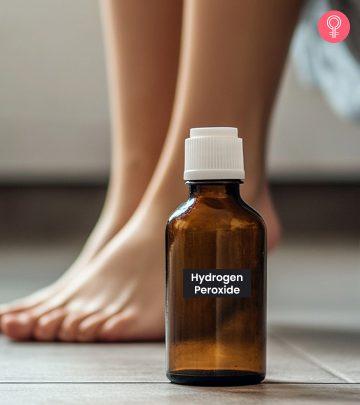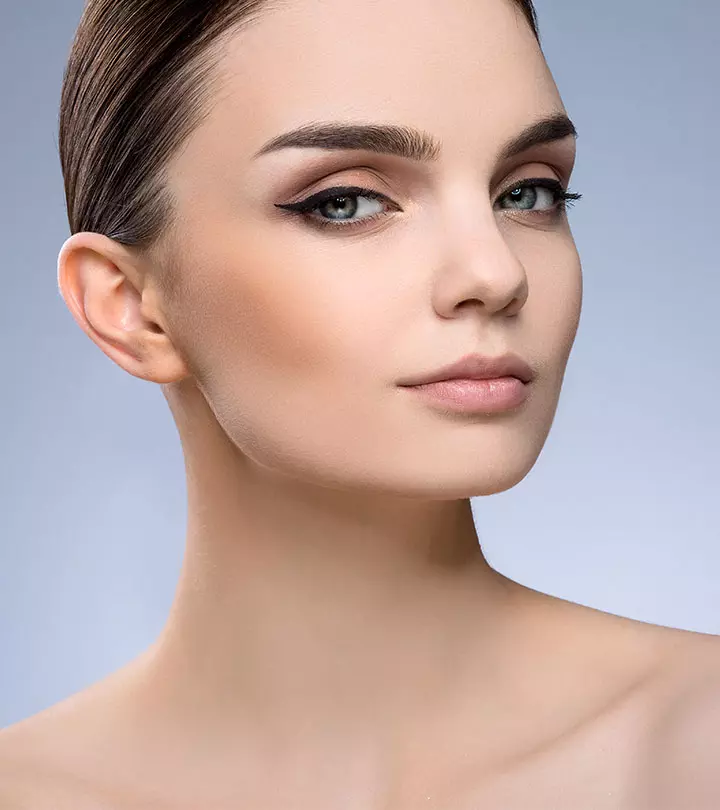How To Get Rid Of Crow’s Feet – 11 Ways & Prevention Tips
Naturally reduce crow's feet with aloe vera, argan oil, or essential oils and facial exercises.

Image: Shutterstock
Crow’s feet are fine lines or wrinkles that form around the outer corners of the eyes. They are a natural part of the aging process often caused by repeated facial expressions. While you cannot get rid of crow’s feet and other aging signs, you can minimize their appearance and make them appear less obvious. We have compiled a list of 11 home cures to help you fade crow’s feet. Continue reading to learn more.

In This Article
What Are Crow’s Feet?
As you age, your skin tends to undergo gradual changes that make certain parts of your face more susceptible than the others to the signs of aging – like the delicate area around your eyes. The little lines or wrinkles that spread out from the corners of your eyes are referred to as crow’s feet. Every time you make a facial expression, there are tiny muscle contractions happening in the muscles of your face. Crow’s feet are the result of such contractions.
There are two main types of wrinkles – dynamic and static wrinkles. While dynamic wrinkles are those that occur due to muscle contractions, i.e., when you smile, static wrinkles worsen with muscle contractions and are visible all the time, even when your face is at rest.
If your crow’s feet are visible only when you are smiling, they are dynamic. Otherwise, they are static.
Many factors and lifestyle choices can worsen or trigger the appearance of crow’s feet, and they are discussed below.
Key Takeaways
- Crow’s feet are the tiny wrinkles that develop near the outside corners of your eyes and are part of natural aging.
- Increased sun exposure and smoking can harm your skin’s collagen and cause crow’s feet.
- Aloe vera boosts the hydration of the skin and reduces facial wrinkles.
- Lemon juice has vitamin C, antioxidants, and anti-aging properties, which may aid in reducing the appearance of crow’s feet.
- To protect your skin, maintain a regular skincare routine and use sunscreen every day.
Causes Of Crow’s Feet

- Frequently squinting or rubbing your eyes
- Increased sun exposure can cause free radical damage that can lead to skin damage and cause crow’s feet.
- Smoking can damage the collagen in your skin, thus contributing to crow’s feet.
- Menopause can result in a drop in your estrogen levels, thus triggering crow’s feet.
- Advancing age
- Your sleeping position: Constantly sleeping on one side can also contribute to crow’s feet and wrinkles.
Crow’s feet can add a few years to your appearance. Here’s a list of home remedies that might make them less prominent.
How To Minimize Crow’s Feet Naturally
1. Aloe Vera

Aloe vera increases collagen production (1). When taken in the dietary form, aloe vera may help in the improvement of facial wrinkles. Moreover, aloe vera has a photoprotectivei Refers to substances used to minimize the deteriorating effects and cancer risks from exposure to UV rays of the sun. effect on the skin (2). Aloe vera also offers a good solution if you are wondering how to get rid of eye bags. However, there are more ways to address puffy eyes, such as tea bags, cold spoons, cucumbers, etc.
You Will Need
1-2 teaspoons of fresh aloe gel
What You Have To Do
- Apply aloe gel around your eyes.
- Leave it on for 15-20 minutes.
- Rinse it off with water.
- You can also have a tablespoon of fresh aloe juice daily.
How Often You Should Do This
You can apply this 2 times daily for best results.
 Quick Tip
Quick Tip2. Argan Oil
Argan oil exhibits anti-aging effects
(3). This may help in improving skin elasticity and assist in reducing the crow’s feet.
You Will Need
1 teaspoon of argan oil
What You Have To Do
- Apply argan oil directly to the skin around your eyes.
- Leave it on until it dries.
- You can also consume food-grade argan oil.
How Often You Should Do This
Apply argan oil 2-3 times daily.
3. Egg White Face Mask
Egg white may help in tightening your pores and reducing the appearance of wrinkles and crow’s feet. Its antioxidant activity may also fight free radical damage. A study in the Korean Journal of Food Science of Animal Resources (2014) found that eggshell membrane hydrolysates (ESMH) may be useful in skincare. The researchers tested different parts of ESMH and discovered that it could reduce inflammation, fight wrinkles by blocking skin-aging enzymes, and have antibacterial properties. It also helped the skin hold moisture better, especially the larger molecules (over 10 kDa). These results suggest that ESMH could be a helpful ingredient in cosmetic products to protect and improve skin health (4).
You Will Need
1-2 egg whites
What You Have To Do
- Whisk the egg white and apply a thin layer to your face and neck.
- Leave it on for 15-25 minutes and then rinse it off with water.
How Often You Should Do This
Do this 2-3 times a week.
4. Coconut Oil

The topical application of virgin coconut oil boosted collagen production of the skin in rats (5). This may also delay the appearance of wrinkles and crow’s feet. Coconut oil can also moisturize the dry skin around the eyes. A clinical trial published in Dermatitis (2004) found that extra virgin coconut oil is just as safe and effective as mineral oil for treating mild to moderate dry skin (xerosis). In the study, 34 patients applied either coconut oil or mineral oil twice daily for two weeks. Both oils improved skin hydration and moisture retention, with no harmful effects or skin irritation. Coconut oil also showed a slight edge in improving symptoms like dryness and roughness, making it a promising natural alternative to traditional moisturizers (6). However, if you are looking for additional remedies for dry skin around the eyes, there are more, such as Vitamin E oil, Shea butter, honey, etc. You may club certain ingredients with coconut oil for better results.
You Will Need
1-2 teaspoons of cold-pressed coconut oil
What You Have To Do
- Apply cold-pressed coconut oil to the affected area.
- Leave it on until it dries completely.
How Often You Should Do This
You can apply coconut oil to your skin multiple times daily.
5. Essential Oils
a. Lemon Essential Oil
Elastase is an enzyme associated with the degeneration of dermal elastin, and it may contribute to aging and wrinkling skin. Lemon oil might help in inhibiting the activity of elastase (7).
You Will Need
- 1-2 drops of lemon essential oil
- 1 teaspoon of any carrier oil (like sweet almond oil or jojoba oil)
What You Have To Do
- Add a drop or two of lemon essential oil to a teaspoon of any carrier oil.
- Mix well and apply it to the affected area.
- Leave it on until it dries.
- You can also rinse it off after 25-30 minutes.
How Often You Should Do This
Do this 1-2 times daily.
b. Grapefruit Essential Oil
Grapefruit oil is an elastase inhibitor (7). Hence, it may help in reducing the appearance of wrinkles and crow’s feet.
You Will Need
- 1-2 drops of grapefruit essential oil
- 1 teaspoon of any carrier oil
What You Have To Do
- Add one to two drops of grapefruit essential oil to any carrier oil.
- Mix well and apply it to the affected area.
- Leave it on for 20-30 minutes before rinsing it off.
How Often You Should Do This
Do this 1-2 times daily.
6. Lemon Juice
Lemon juice or any citrus juice possesses antioxidant and anti-ageing properties (8). It also contains vitamin C that has anti-ageing effects and protects the skin from photodamage (9). These factors may help in decreasing skin thickness and the appearance of wrinkles.
You Will Need
- ½ lemon
- 1 glass of water
- Honey (optional)
What You Have To Do
- Squeeze the juice from half a lemon into a glass of water.
- Mix well and add some honey if required.
- Drink the fresh lemon juice.
- You can also rub a lemon slice all over your face and wash it off after 15-20 minutes.
How Often You Should Do This
Drink this juice 1-2 times daily.
7. Vitamin E Oil
Vitamin E has photoprotective effects (10). This property may help in repairing free radical damage that leads to aging and wrinkling skin.
You Will Need
1-2 vitamin E capsules or 1 teaspoon of vitamin E oil
What You Have To Do
- Apply a thin layer of vitamin E oil to the affected area.
- You can also consume vitamin E-rich foods like nuts, sunflower seeds, and green leafy vegetables.
How Often You Should Do This
Do this at least once daily.
8. Avocado Oil

Rat studies show that avocado oil may increase collagen production. A study published in Connective Tissue Research found that certain avocado oils can positively impact skin collagen in rats. Rats that consumed unrefined avocado oil, avocado seed oil, or the unsaponifiable parts of the oil had a notable increase in soluble collagen in their skin. This likely happened due to the inhibition of lysyl oxidase, an enzyme involved in collagen cross-linking. Interestingly, this effect was linked to components from the avocado seed, as only those fractions influenced collagen metabolism. In contrast, refined avocado oil and soybean oils (refined or unrefined) had no such impact (11). Hence, avocado oil may help you deal with aging skin and wrinkles.
It is also a popular sunken eye remedy. However, there are more options if you’re looking for some specific sunken eye remedy, such as castor oil, cucumber, etc. Determining the symptoms can lead you to the right solution.
You Will Need
1 teaspoon of unrefined avocado oil
What You Have To Do
- Using your fingertips, apply a thin layer of the oil all over the crow’s feet.
- Allow the oil to dry naturally.
- You can also include avocado in your diet.
How Often You Should Do This
You can do this once daily.
9. Garlic
Garlic helps repair free radical damage caused by increased exposure to the sun due to their antioxidant properties (12). This may help in improving the appearance of crow’s feet and wrinkles.
You Will Need
1-2 garlic cloves
What You Have To Do
You can either chew on the garlic cloves directly or add them to your favourite dish.
How Often You Should Do This
You may do this once daily.
10. Milk
Milk proteins are used in multiple cosmetic products for their moisturizing and nourishing properties. Further, milk proteins such as proline and threonine may boost elastin and collagen production and heal tissues. This may help get rid of wrinkles and crow’s feet naturally (13).
You Will Need
- A bowl of chilled whole milk
- Cotton pads or balls
What You Have To Do
- Soak the cotton in a bowl of chilled milk, just enough to be drenched but not dripping.
- Place it on the crow’s feet areas around your eyes.
- Lay back and relax for 10-15 minutes.
- Remove the cotton and rinse your face with cool water.
- Follow it up with a moisturizer.
How Often You Should Do This
You may do this once daily or every alternate day.
11. Face Exercises
Facial exercises may help in reducing the appearance of crow’s feet. They include:
- Eye Tapping – Tap along the natural curve of your eyes gently with the pads of your fingers to promote blood flow to the eyes.
- Crow’s Feet Tension Reliever – Using your index finger and thumb, pinch the skin under your eyebrows and roll it gently between the pads of your fingers to relieve tension.
- Eye Wrinkle Stretch – Place each of your index fingers on the outer corners of both your eyebrows and move your fingers upwards to stretch the skin there gently.
- Eye Wrinkle Pressure Hold – Place your index finger and middle finger on either side of the eye wrinkles and gently press down.
Parmita, a vlogger, shared how regularly doing facial exercises have helped reduce the wrinkles around her eyes. She said, “If I forget to exercise my eyelids or eye area for several days or weeks, my eyelids will begin to descend (i).”
It is important to note that some individuals may experience side effects such as skin irritation, allergic reactions, or sensitivity to sunlight, especially when using potent ingredients like lemon juice or essential oils.
For instance, lemon essential oil can make the skin more prone to sunburn if not properly diluted or used with sun protection. Similarly, garlic and raw egg white may trigger allergic responses in sensitive individuals, and coconut oil, though moisturizing, might clog pores in acne-prone skin.
Therefore, it’s always best to conduct a patch test before applying any new remedy to your face and consult a dermatologist if you have sensitive skin or underlying skin conditions.
Apart from the above remedies, there are also some invasive and non-invasive treatments you can consider to help reduce the appearance of crow’s feet. Continue reading to learn more about it.
Treatment Options
- Topical Treatments (Non-Invasive): Retinol or peptide creams can be applied to the skin to stimulate collagen and reduce fine lines (14).
- Botox Injections (Minimally Invasive): Botox works by blocking the release of acetylcholine at nerve endings, temporarily relaxing muscles, and reducing wrinkles (15).
- Dermal Fillers (Minimally Invasive): Used to reduce fine wrinkles and improve skin elasticity around the crow’s feet area by stimulating collagen growth (16).
- Laser Therapy (Minimally Invasive): Uses targeted light at specific wavelengths to stimulate collagen and elastin production and tighten skin (17).
- Microneedling (Minimally Invasive): Tiny needles create micro-injuries that encourage skin repair and elasticity (18).
While these remedies, treatments, and exercises may help reduce the appearance of crow’s feet, here are some tips that might help prevent them from worsening. On that note, checking out more eye care tips will be an added benefit as they will also tell you crucial home remedies and essential eye care tips for better results.
Prevention Tips
- Limit your exposure to the sun. Always apply sunscreen before stepping out.
- Follow a healthy diet that contains fresh fruits, vegetables, and whole grains to protect your skin from free radical damage.
- Exercise regularly.
- Quit smoking.
- Avoid using tanning beds.
- Moisturize your skin regularly.
- Drink plenty of water throughout the day to keep your skin hydrated and maintain its elasticity.
 Quick Tip
Quick TipInfographic: 7 Typical Signs Of Skin Aging
With age, the skin begins to lose its youthful appearance. While it is a completely natural phenomenon and irreversible, skin aging can be slowed down with proper care and effort. It is ideal to start giving your skin some extra care and attention as soon as you spot the signs of aging creeping in.
Check out the infographic to know what the most common signs of aging are so that you can slow them down in their tracks and keep your skin looking radiant and youthful for longer.
Some thing wrong with infographic shortcode. please verify shortcode syntax
The best way to get rid of crow’s feet is to prevent or delay its appearance in the first place. These fine lines or wrinkles spreading out from your eyes are stubborn aging signs that are tough to treat. However, you can make them less visible by taking a few remedial actions. Natural ingredients like aloe vera, argan oil, egg whites, coconut oil, essential oils, lemon juice, vitamin E oil, etc., have anti-aging properties and work well to reduce premature aging signs like fine lines and wrinkles. Besides, doing face exercises may also help. Limit sun exposure, use sun protection daily, and make certain lifestyle changes like eating right, exercising regularly, quitting smoking, etc., to delay the onset of crow’s feet.
Frequently Asked Questions
At what age do you get crow’s feet?
While the chances of developing crow’s feet increase with age and skin damage, they may also occur in some individuals as early as in the mid-20s.
What is the best cream for crow’s feet?
One of the best topical creams used to fight crow’s feet is Tretinoini A type of vitamin A that increases your skin’s cell turnover rate and is thus often used as an anti-aging treatment. . Those aged between 30-50 years can opt for laser treatment, skin tightening surgery, or botox botox treatmenti A treatment in which botulinum toxins are injected to inhibit muscle contractions and reduce visible signs of aging. to smoothen out the crow’s feet as well as wrinkles. Make sure you consult a dermatologist and understand the treatment options available before going for the best one for you.
Can you put filler in crow’s feet?
Yes, you may opt for soft-tissue filleri A type of injection also known as a dermal filler that is used to contour facial features and correct wrinkles and fine lines. therapy to improve the appearance of crow’s feet. The results usually last for around 3-4 months and need follow-up sessions to maintain.
Does cucumber help crow’s feet?
Yes, cucumber contains potent antioxidants that may help reduce the appearance of crow’s feet and help with skin rejuvenation around the eyes. According to a study, cucumber extract can help minimize wrinkle formation. Hence, it finds wide use in cosmetics and other beauty products (19).
Personal Experience: Source
StyleCraze's articles are interwoven with authentic personal narratives that provide depth and resonance to our content. Below are the sources of the personal accounts referenced in this article.
(i) 6 Eye Exercises: Tighten Droopy Eyelids and Reduce Wrinkles Around Eyes/ Blushwithme-Parmitahttps://www.youtube.com/watch?v=X12oV-tVIpQ
References
Articles on StyleCraze are backed by verified information from peer-reviewed and academic research papers, reputed organizations, research institutions, and medical associations to ensure accuracy and relevance. Read our editorial policy to learn more.
- Cho, Soyun et al. “Dietary Aloe Vera Supplementation Improves Facial Wrinkles and Elasticity and It Increases the Type I Procollagen Gene Expression in Human Skin in vivo.” Annals of dermatology vol. 21,1 (2009): 6-11.
https://www.ncbi.nlm.nih.gov/pmc/articles/PMC2883372/ - Surjushe, Amar et al. “Aloe vera: a short review.” Indian journal of dermatology vol. 53,4 (2008): 163-6. doi:10.4103/0019-5154.44785
https://www.ncbi.nlm.nih.gov/pmc/articles/PMC2763764/ - Boucetta, Kenza Qiraouani et al. “The effect of dietary and/or cosmetic argan oil on postmenopausal skin elasticity.” Clinical interventions in aging vol. 10 339-49.
https://www.ncbi.nlm.nih.gov/pmc/articles/PMC4321565/ - Yoo, Jinhee et al. “Effects of Egg Shell Membrane Hydrolysates on Anti-Inflammatory, Anti-Wrinkle, Anti-Microbial Activity and Moisture-Protection.” Korean journal for food science of animal resources vol. 34,1 (2014): 26-32.
https://www.ncbi.nlm.nih.gov/pmc/articles/PMC4597828/ - Nevin, K G, and T Rajamohan. “Effect of topical application of virgin coconut oil on skin components and antioxidant status during dermal wound healing in young rats.” Skin pharmacology and physiology vol. 23,6 (2010): 290-7.
https://pubmed.ncbi.nlm.nih.gov/20523108/ - Agero, Anna Liza C, and Vermén M Verallo-Rowell. “A randomized double-blind controlled trial comparing extra virgin coconut oil with mineral oil as a moisturizer for mild to moderate xerosis.” Dermatitis : contact, atopic, occupational, drug vol. 15,3 (2004): 109-16.
https://pubmed.ncbi.nlm.nih.gov/15724344/ - Mori, Masahiro et al. “Inhibition of elastase activity by essential oils in vitro.” Journal of cosmetic dermatology vol. 1,4 (2002): 183-7.
https://pubmed.ncbi.nlm.nih.gov/17147537/ - Kim, Dan-Bi et al. “Antioxidant and anti-ageing activities of citrus-based juice mixture.” Food chemistry vol. 194 (2016): 920-7.
https://pubmed.ncbi.nlm.nih.gov/26471635/ - Al-Niaimi, Firas, and Nicole Yi Zhen Chiang. “Topical Vitamin C and the Skin: Mechanisms of Action and Clinical Applications.” The Journal of clinical and aesthetic dermatology vol. 10,7 (2017): 14-17.
https://www.ncbi.nlm.nih.gov/pmc/articles/PMC5605218/ - Nachbar, F, and H C Korting. “The role of vitamin E in normal and damaged skin.” Journal of molecular medicine (Berlin, Germany) vol. 73,1 (1995): 7-17.
https://pubmed.ncbi.nlm.nih.gov/7633944/ - Werman, M J et al. “The effect of various avocado oils on skin collagen metabolism.” Connective tissue research vol. 26,1-2 (1991): 1-10.
https://www.tandfonline.com/doi/abs/10.3109/03008209109152159 - Rahman, Khalid. “Garlic and Aging: New Insights into an Old Remedy.” Ageing Research Reviews, Elsevier.
www.sciencedirect.com/science/article/pii/S1568163702000491 - Kazimierska, Kinga, and Urszula Kalinowska-Lis. “Milk Proteins-Their Biological Activities and Use in Cosmetics and Dermatology.” Molecules (Basel, Switzerland) vol. 26,11 3253. 28 May. 2025
https://www.ncbi.nlm.nih.gov/pmc/articles/PMC8197926/ - Hamie H, Yassine R, Shoukfeh R, Turk D, Huq F, Moossavi M. “A review of the efficacy of popular eye cream ingredients.” Int J Womens Dermatol. 2025 Jun 13.
https://pmc.ncbi.nlm.nih.gov/articles/PMC11175953/ - Satriyasa BK. “Botulinum toxin (Botox) A for reducing the appearance of facial wrinkles: a literature review of clinical use and pharmacological aspect.” Clin Cosmet Investig Dermatol. 2019 Apr 10.
https://pmc.ncbi.nlm.nih.gov/articles/PMC6489637/ - Jeong GJ, Ahn GR, Park SJ, Hong JY, Kim BJ. “A randomized, patient/evaluator-blinded, split-face study to compare the efficacy and safety of polycaprolactone and polynucleotide fillers in the correction of crow’s feet: The latest biostimulatory dermal filler for crow’s feet.” J Cosmet Dermatol. 2025.
https://onlinelibrary.wiley.com/doi/10.1111/jocd.13199 - Kitzmiller WJ, Visscher M, Page DA, Wicket RR, Kitzmiller KW, Singer LJ. “A controlled evaluation of dermabrasion versus CO2 laser resurfacing for the treatment of perioral wrinkles.” Plast Reconstr Surg. 2000 Nov.
https://pubmed.ncbi.nlm.nih.gov/11083571/ - Litchman G, Nair PA, Badri T, et al. “Microneedling.” [Updated 2025 Sep 26]. In: StatPearls [Internet]. Treasure Island (FL): StatPearls Publishing; 2025 Jan.
https://www.ncbi.nlm.nih.gov/books/NBK459344/ - Nema, Neelesh K et al. “Cucumis sativus fruit-potential antioxidant, anti-hyaluronidase, and anti-elastase agent.” Archives of dermatological research vol. 303,4 (2011): 247-52.
https://pubmed.ncbi.nlm.nih.gov/21153830/
Find out the tried-and-true methods for effectively treating crow’s feet in this informative video. Discover the best strategies to rejuvenate your skin and achieve a youthful look. Watch it now!
Read full bio of Dr. Priya Gill
Read full bio of Sucharita Mishra
Read full bio of Anjali Sayee
Read full bio of Monomita Chakraborty


























Community Experiences
Join the conversation and become a part of our empowering community! Share your stories, experiences, and insights to connect with other beauty, lifestyle, and health enthusiasts.